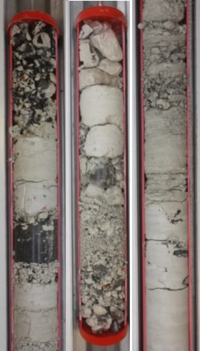Difference between revisions of "Physical processes and governing equations"
m (→Physical processes) |
m (→Flow) |
||
| Line 7: | Line 7: | ||
=== Flow === | === Flow === | ||
Groundwater flow in porous media is usually described by Darcy's law, giving a relation between hydraulic head gradient and groundwater flow. | Groundwater flow in porous media is usually described by Darcy's law, giving a relation between hydraulic head gradient and groundwater flow. | ||
| − | The fracture conductivity is usually determined via the fracture aperture using the cubic law | + | The fracture conductivity is usually determined via the fracture aperture using the '''cubic law'''. |
| − | |||
| − | |||
| − | |||
| − | |||
Flow equation. | Flow equation. | ||
Revision as of 15:50, 16 November 2016
Contents
Physical processes
Transport of substances in fractured porous media can be subdivided in advective and transport (due to the groundwater flow) and diffusive/dispersive transport. The storage of substances is strongly influenced by sorption of the substance to the porous medium. This is often quantified as retardation, using a retardation factor.
Governing equations
Flow
Groundwater flow in porous media is usually described by Darcy's law, giving a relation between hydraulic head gradient and groundwater flow. The fracture conductivity is usually determined via the fracture aperture using the cubic law.
Flow equation.
Contaminant transport
To describe the transport of a substance in a porous medium, the advection-dispersion equation is usually employed. It includes the storage, advective and dispersive transport of a substance. Retardation due to sorption and degradation can be included.
Properties of limestone
Low conductive matrix - can be heavily fractured - chert layers and nodules - varying hardness - sorption behavior for chlorinated solvents
Return to Content
